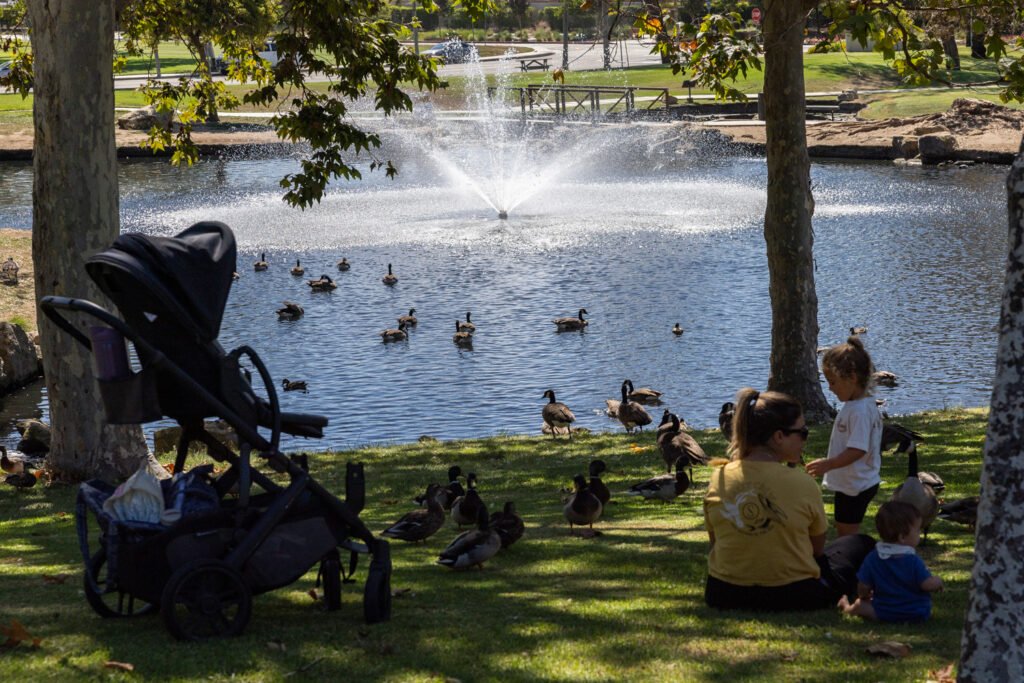The Iconic Lakes at TeWinkle Park: A Vital Resurgence for Costa Mesa’s Heart
Amidst the laughter of children and the gentle quacks of ducks, Bri Mooneyham reflects on TeWinkle Park, a place where memories become woven into the fabric of community life. “I celebrated my daughter’s birthday here,” she recalls, her eyes glistening with nostalgia. “It’s been a place for family outings and sports, a refuge just steps from home.” This sentiment resonates deeply among Costa Mesa residents, who cherish the park’s serene lakes and lush surroundings.
A Long-Awaited Transformation
TeWinkle Park is set to undergo a significant transformation, revitalizing its iconic lakes with a much-needed $2.5 million renovation. The roughly two-acre expanse has long been a beloved gathering spot, but years of seepage—over 1 million gallons of water lost monthly—have prompted city officials to take decisive action. The lakes’ upkeep has cost taxpayers around $100,000 annually, and high nitrate levels from the local waterfowl population have raised concerns about environmental impact.
- Cost of renovation: $2.5 million
- Current water loss: 1 million gallons/month
- Annual expenditure on maintenance: $100,000
- High nitrate levels due to waterfowl waste
Addressing these challenges, the city council voted narrowly to replace the lake liner, deepen the lakes, repair shorelines, and enhance aesthetics to guide waterfowl to designated areas. The renovation is part of a broader initiative to ensure the park remains a vibrant community hub.
The Balancing Act of Tradition and Modern Needs
Discussions surrounding the lakes have stirred passionate debates among city council members. Councilmember Loren Gameros raised eyebrows with a bold proposition: “Why not fill the lakes and create grassy knolls instead? Let’s create a space for families that doesn’t drain our resources.” This perspective highlights a crucial tension in urban planning—balancing traditional community spaces with modern necessities.
In response, Mayor John Stephens countered, “We don’t want to lose a space that so many of us cherish. These lakes are integral to our community identity.” His statement reiterates the need for preservation amidst rising maintenance costs. This intricate dance between preserving nostalgia and adapting to evolving community needs encapsulates the emotional stakes involved.
A Place for Connection
TeWinkle Park is not merely a recreational area; it is a sanctuary where lifelong connections form. Resident Cynthia McDonald shared her thoughts during the council meeting, saying, “It’s a tradition for Costa Mesa High students to take their senior photos here. The joy that these lakes bring is immeasurable.” Such reflections underscore the lakes’ role in weaving the community narrative.
The park, named after Costa Mesa’s first mayor, Charles TeWinkle, embodies more than just flora and fauna. It carries a sense of heritage and attachment deeply rooted in the hearts of local residents. According to Dr. Emily Kim, a sociologist specializing in urban studies at Chapman University, “Spaces like TeWinkle Park are essential for community cohesion. They provide not just leisure but also a sense of belonging and identity.” As the renovation unfolds, this bond will be crucial in guiding how residents interact with their environment.
Perceptions and Projections
While many residents eagerly await the positive changes, others harbor concerns about the ecological impact of the lakes. Jose Luis Gonzalez, who frequents the park, voiced his worries. “The ducks need this space. They rely on it to survive. We must ensure the lakes are managed sustainably,” he explained, highlighting the intrinsic link between community and nature.
Comprehensive studies affirm the importance of green spaces like TeWinkle Park. According to a recent survey conducted by the Urban Ecology Institute, access to parks is pivotal for community health and well-being. Their findings show that residents living within a 10-minute walk of parks report higher levels of physical activity and mental well-being.
Dr. Clara Baker, an environmental scientist, adds, “This renovation is an opportunity not just for restoration, but for implementing sustainable practices that will benefit both residents and the local ecosystem.” Her perspective brings to light the need for an adaptive approach that nurtures the park’s legacy while embracing ecological stewardship.
A Community Landmark Reclaimed
The anticipated renovation is a reminder that TeWinkle Park is not merely a piece of land—it represents collective memories and aspirations. Councilwoman Andrea Marr assured residents of their love for the lakes, stating, “Getting rid of these lakes would spark overwhelming opposition. People feel passionately about what this park represents.” This deep-seated attachment indicates the silent but powerful role that parks like TeWinkle play in maintaining community fabric.
The funding for the upgrade will be sourced partly from a $10 million state grant, ensuring that the financial burden is shared responsibly. “Investing in our parks is investing in our community,” stated Councilwoman Arlis Reynolds, poignantly suggesting that green spaces often receive less attention than they deserve in municipal planning.
As the project rolls out in the coming months, local residents will have a direct say in its evolution. Council members have indicated plans for public forums to gather input on the renovations, ensuring community voices shape decisions that impact their cherished spaces.
The vibrant hues of autumn leaves rustling in the breeze punctuate the air as families gather by the lakes, capturing memories against the backdrop of ducks gliding gracefully on the surface. For many in Costa Mesa, TeWinkle Park’s lakes are not merely a physical space; they are a cherished aspect of their lives—one that will receive the care it deserves, breathing new life into an iconic landmark that spans generations.





